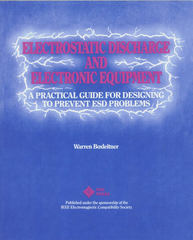
Electrostatic Discharge and Electronic Equipment: A Practical Guide
W. Boxleitner
(1999) 118 pages
Today, in the electronics industry, there is probably no other area which is so poorly understood as ESD. Unfortunately the increase in the occurance of ESD problems has not been accompanied by a corresponding increase in knowledge about ESD. This book was written to take the mystery out of ESD. It explains how ESD is generated, and how it affects electronic equipment. Even more important, this book explains how to design equipment to prevent ESD problems. Finally, a thorough discussion of ESD testing is included, covering not only test hardware, but also procedures and methods that ensure meaningful results.
@ A Model of the Electrostatic Discharge (ESD) Event; ESD Effects in Electronic Equipment; Firmware/Software Design Guidelines; Printed Wiring Board Design Guidelines:; Six PWB guidelines address the specifics of: Loop Areas:Line Lengths:Ground Planes:Capacitance:Isolation:Chassis Ground on the PWB:@ ; Overall Priority of Design Rules; Summary of PWB Design Guidelines; Cable Design Guidelines:; Fourteen cable guidelines address the specifics of: Electrochemical Series:Anodic and Cathodic Materials:Electrolytic Corrosion:Oxidation:Air Separation:Shielded Cables and Chassis Ground:Cable Shield Thickness:Cable Shield Connections:Cable Entry Point:Option to Connect the Cable Shield to Logic Ground:The ESD Current and Ferrites:Ferrite Bead Placement:Extra Lines:Flat Cables:@ ; Summary of Cable Design Guidelines; Enclosure Design Guidelines:; Twenty-one enclosure guidelines address the specifics of: Enclosures and Chassis Ground:Separations for Grounded Items:Separations for Ungrounded Items:Secondary Arcs:Enclosures and Operators:Enclosures and PWB Design:Enclosures and I/O Devices:I/O Cable Location:Connection of Cable Shield to Chassis Point(s):Ferrites Near the Cable Entry Point:Slots or Holes:Small Openings and Large Openings:Space Between Openings:Slot Locations:Shielding Seams:Conductive Gaskets:Gaskets, Fasteners and Corrosion:Foil Tape:Shield Seam Overlap:Bonding Straps:@ ; Summary of Enclosure Design Guidelines; Electronic Circuit Design Guidelines:; Eight guidelines address the specfics of: Component Limits:Circuit or System Disabling:Critical Inputs:Sensitive Devices:Sensitive Inputs:Floating Inputs:Filters VII:Clamping Suppressors:@ ; Summary of Electronic Circuit Design Guidelines; Manufacturing, Shipping, and Installation Guidelines:; Nine guidelines address the specifics of: Dielectric Materials:Dielectric Material Contact:Conductive Materials:Ionizers:Handling of Components or Assemblies:Shields:Ground Paths:Protection System Checks:@ ; Summary of Manufacturing, Shipping, and Installation Guidelines; ESD Simulator Design and Usage:; Three guidelines address the specifics of: ESD Simulators and Human Body Inductance:ESD Simulators and the Human Arm, Hand, and Finger:Proper R, L, and C Values:@ ; Guidelines for ESD Facilities and Test Methods:; Twenty-one guidelines address the specifics of: Boundary of the ESD Test Area:Isolation Transformers:Ground Planes:Table Ground Planes:Discharge Point Choice:Isolated AC Source:Simulator Chassis Ground:Simulator Location:ESD Simulator Charge:Simulator Position:Stray Capacitance of the EUT (Equipment Under Test):Indirect Tests:EUT Physical Configuration:Failure Definitions:Statistically Derived Sample Size:Test Progression:Error Detection:Test Limits:"Calibration" of the ESD Test Bed:Safety:@ ; Statistical Sampling Criteria:; Why Most Tests Don't Work; How Sure and How Good?; Confidence Levels and Limits in Brief; Proper Sampling for Units with Low Failure Rates; Proper Sampling for Larger Failure Rates; Comparative Testing; Summary; Sample ESD Test Specification:; Standard Acceptance Test Number 1 for ESD; Standard Acceptance Test Number 2 for ESD; Standard Acceptance Test Number 3 for ESD; ESD Failure Definitions; ESD Test Instructions; ESD Test Data Sheet for Acceptance Test Number 1; ESD Test Data Sheet for Acceptance Test Number 2; ESD Test Data Sheet for Acceptance Test Number 3; Standard Comparative Test Criteria for ESD; ESD Test Data Sheet for Comparison Testing
Contact us at info@electrostatic.com
https://www.electrostatic.com/ (jmc 2023-11-02) © 2023
 Electrostatic Applications
Electrostatic Applications